Every pond owner, at some point, will probably have to deal with a leak.
Some of the links in this article may be affiliate links. If you make a purchase through these links, we may earn a small commission at no extra cost to you. Thank you.
It’s inevitable but what we can choose, is how we deal with it.
There are lots of great products and techniques available , and I have covered some in my beginners guide to fixing pond leaks, but what if you have other considerations such as how to get good results without harming the pond’s delicate eco-system.
That’s where these eco-friendly ways to fix pond leaks comes into play. Let’s take a closer look.
Summary
- We utilize eco-friendly bentonite clay sealants that expand and form watertight barriers upon contact with water.
- For sustainable liner replacements, we recommend recycled polyethylene tarps, rubber liners, and geotextile fabric.
- Natural plant-based sealants like liquid rubber and hydraulic cement are effective in sealing leaks.
- To drain ponds for repairs in an environmentally friendly way, consider using submersible pumps or gravity drains.
- Additionally, compressed peat, polymers, and rainwater harvesting systems provide chemical-free solutions for leaks.
- These methods not only fix leaks but also help preserve the delicate balance of aquatic ecosystems.
So, lets explore further to gain a deeper understanding of eco-friendly solutions for pond leaks.
Understanding Pond Leaks
To better understand why ponds develop leaks, it’s crucial to consider various factors that can contribute to this issue. One common reason is the use of subpar construction materials or inadequate waterproofing techniques during the pond’s setup. As time passes, these materials can deteriorate, leading to cracks and leaks that allow water to escape.
Soil erosion or settling is another significant cause of pond leaks, as it can result in gaps or fissures in the pond’s structure. This problem is more prevalent in areas with unstable soil conditions or where proper compaction wasn’t done during the pond’s construction.
Harsh weather conditions, such as freezing temperatures or droughts, can also strain the pond’s materials, causing them to expand, contract, or shift, ultimately leading to leaks.
The growth of tree roots near the pond can puncture its lining or structure, creating openings for water to leak out. Similarly, burrowing animals like muskrats or groundhogs can tunnel beneath the pond, compromising its integrity. Understanding these potential causes is essential for effectively addressing leaks and preventing further water loss.
Bentonite Clay Sealants
Let’s take a closer look at the eco-friendly option of bentonite clay sealants. These sealants, made from clay, are excellent at sealing leaks because they expand when in contact with water.
We’ll cover how to apply them, their environmental impact, and the benefits of using this natural and non-toxic material.
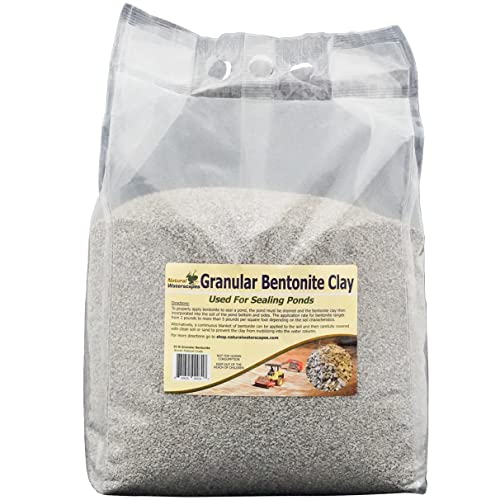
Bentonite Clay Properties
Bentonite clay is a fantastic solution for fixing pond leaks due to its eco-friendly nature and affordability. This clay expands when in contact with water, forming a dense, watertight barrier that effectively seals any cracks or holes. What sets bentonite clay apart is its non-toxic composition, making it safe for aquatic life and the environment.
A major benefit of bentonite clay is its flexibility to conform to various shapes and surfaces, ensuring thorough coverage and sealing. Its durability is impressive, as it can withstand erosion and maintain its effectiveness over an extended period. When applied correctly, bentonite clay can provide long-lasting results, often lasting for years before requiring reapplication.
Moreover, bentonite clay offers versatility as it can be used alone or mixed with other materials like cement or polymers to enhance strength and longevity. It complements different pond liners and is suitable for both new constructions and existing ponds.
Application Methods
To effectively seal pond leaks with bentonite clay, proper application methods are crucial. The process begins by draining the pond as much as possible to access the leak area.
The next step involves mixing the bentonite clay with water according to the manufacturer’s instructions to create a slurry. This slurry is then applied directly onto the leak using a trowel or sprayer, ensuring thorough coverage.

It is important to apply the slurry in multiple thin layers, allowing each layer to partially dry before adding the next one. This layering technique enhances the sealing effectiveness of the bentonite clay.
Once the final layer is completely dry, the pond can be refilled. The bentonite clay will expand upon contact with water, creating a tight and impermeable seal around the leak.
For larger leaks or cracks, incorporating a geotextile fabric or pond liner before applying the bentonite slurry can provide additional reinforcement for a more durable repair.
Environmental Considerations
Using bentonite clay sealants for pond leaks isn’t only a practical solution but also an environmentally friendly choice. Bentonite clay, a natural mineral, is non-toxic and biodegradable, ensuring minimal impact on the ecosystem. When applied properly, it forms a waterproof barrier that effectively seals leaks without causing harm to aquatic life.
One of the key advantages of bentonite clay sealants is their compatibility with aquatic organisms such as fish and plants when used correctly. Unlike synthetic sealants, bentonite clay doesn’t release harmful chemicals into the water or soil, reducing the chemical footprint in the environment. Additionally, bentonite deposits are abundant and can be mined sustainably with minimal impact on the surrounding environment.
Over time, bentonite clay sealants naturally biodegrade without leaving any toxic residues behind.
Eco-Friendly Liner Replacements
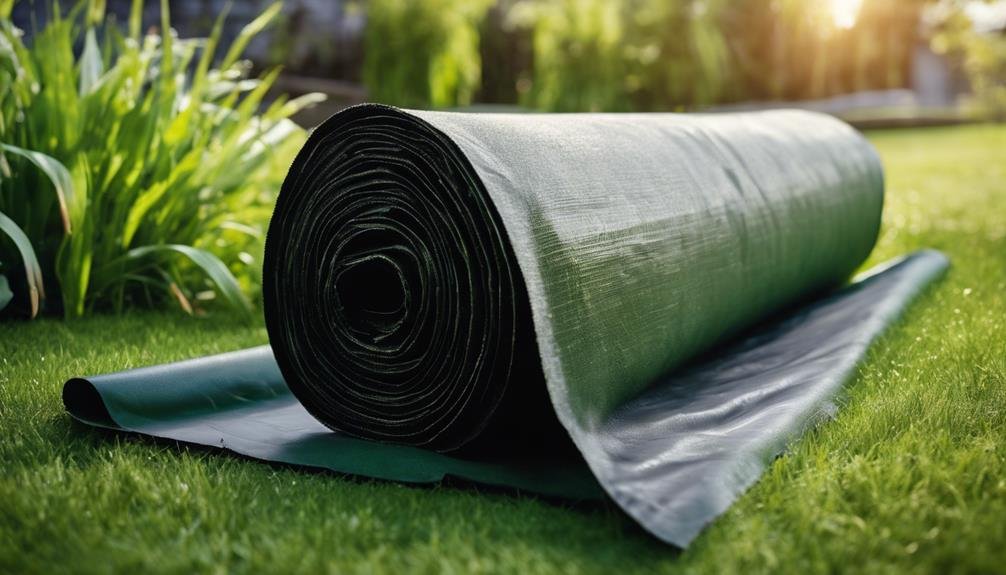
Looking for an eco-friendly solution to replace a leaky pond liner? Consider using recycled polyethylene tarps, which are cost-effective and durable. These tarps are resistant to UV rays, punctures, and chemicals, making them a suitable option for ponds. However, it’s important to note that they aren’t biodegradable and may contain traces of harmful substances from the recycling process.
Rubber liners made from recycled tires or other sustainable materials are another option to consider. While they’re eco-friendly and long-lasting, they can be pricey and require professional installation.
On the other hand, Bentonite clay is a natural and inexpensive alternative, but it may develop leaks over time and require regular maintenance.
Geotextile fabric is also worth mentioning for its permeability and erosion prevention qualities, although it’s not waterproof and may need an additional lining for ponds.
When choosing the right liner replacement for your pond, consider factors such as your budget, pond size, and environmental concerns. Each option has its own set of benefits and drawbacks, so it’s essential to weigh them carefully before making a decision.
Natural Pond Sealants
If you’re a pond owner who values nature and wants an eco-friendly solution, natural pond sealants are worth considering. These environmentally conscious options can effectively seal leaks without causing harm to the ecosystem around your pond.
Here are four popular choices to explore:
- Bentonite clay is a natural clay that swells when in contact with water, creating a tight seal. It’s safe for aquatic life and non-toxic.
- Sodium bentonite, similar to bentonite clay, expands to fill cracks and holes, forming a strong barrier against leaks.
- Liquid rubber sealants, made from plant-based materials, create a waterproof membrane that can adapt to different surfaces while being flexible.
- Hydraulic cement, a mix of natural pozzolans and lime, sets and hardens when exposed to water, effectively sealing leaks from within.
When choosing a natural sealant, consider factors like the size and severity of the leak, compatibility with your pond’s materials, and the overall impact on the environment.
With careful application, these eco-friendly options can help you fix leaks while keeping your pond’s natural beauty intact.
Drain and Repair
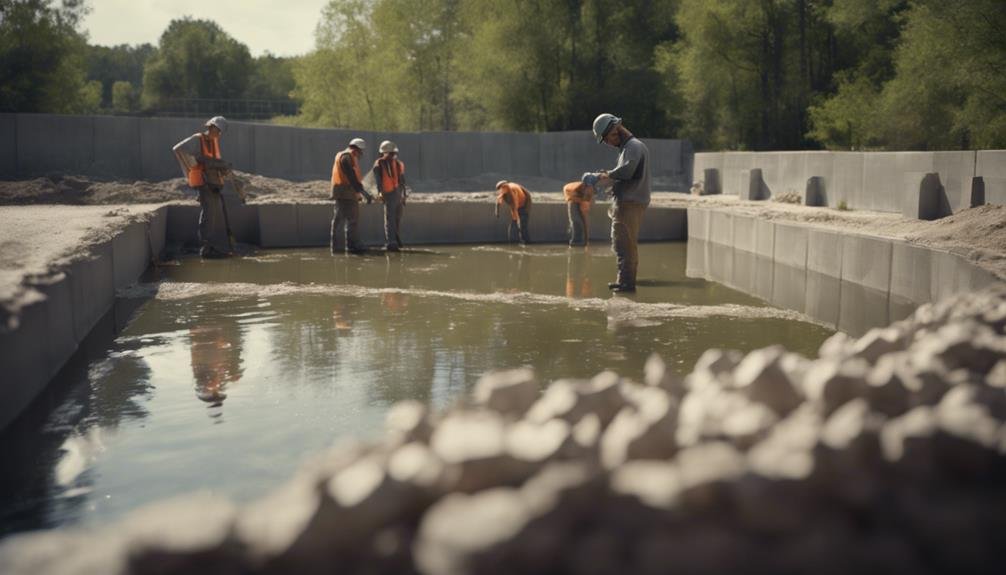
To kickstart the repair process, let’s delve into various methods for draining ponds tailored to different scenarios.
It’s crucial to accurately detect leaks, as pinpointing the source is key. We’ll discuss effective leak detection techniques that can help in this process.
Additionally, we’ll explore options for repairing liners, including the use of patching materials and considering complete liner replacement when necessary.
Pond Draining Methods
When draining your pond for repairs or maintenance, it’s essential to do so efficiently and in an eco-friendly manner. Here are some methods you can use:
- Gravity Drain: Connect a hose to the pond’s drain valve and let gravity slowly release the water into a nearby ditch or drainage area. This method minimizes disturbance to the environment around the pond.
- Submersible Pump: Place a submersible pump in the deepest part of the pond and use a hose to direct the water to a suitable drainage area. This method allows for quicker draining but requires access to electricity.
- Siphon System: Create a siphon using a garden hose and prime it with water to establish a continuous flow of water out of the pond without the need for a pump. This energy-efficient and cost-effective method is eco-friendly.
- Partial Drain: If a full drain isn’t necessary, lower the water level enough to access the repair area. This reduces the amount of water displaced and minimizes the impact on the pond’s ecosystem.
Regardless of the method chosen, ensure that the drained water is directed to a safe location to avoid any potential contamination or erosion issues.
Make sure to follow these eco-friendly draining methods for a healthier pond environment.
Leak Detection Techniques
Detecting leaks in ponds accurately and efficiently is crucial before initiating any repair work to save time and resources. There are various methods available to identify leaks in a pond. One simple approach is the bucket test, where the pond’s inlet and outlet are sealed, and the water level is monitored over time using a marked bucket. A decrease in water level indicates the presence of a leak.
Alternatively, using pond dye or leak detection dye can also help locate leaks. By adding dye to the pond water and observing where the colored water seeps out, we can pinpoint the leak’s location. These dyes are environmentally friendly and safe for aquatic life.
For larger ponds, hiring professionals equipped with specialized tools like leak detection cameras or listening discs may be necessary. Although more costly, these tools can accurately identify leaks, saving time and effort that would otherwise be spent on unnecessary digging. Precise leak detection ensures that repairs target the root cause effectively, minimizing disruptions to the pond environment.
Regardless of the chosen method, precise leak detection is essential before proceeding with repairs. It enables us to address the issue strategically, reducing the need for extensive digging or draining.
Liner Repair Options
Once we’ve pinpointed the location of the leak, our most thorough repair method involves draining the pond to address the liner directly. Here’s a breakdown of the steps we typically take:
- Completely drain the pond to allow the liner to dry.
- Clear away any debris or vegetation covering the damaged area.
- Utilize a pond liner repair kit for patching, containing liner adhesive or sealant, patching material like PVC or EPDM, and necessary cleaning supplies.
- Carefully follow the instructions provided in the kit, ensuring the area is clean and dry before applying the adhesive and patch.
This approach offers a durable and environmentally friendly solution, avoiding the use of chemical-based sealants that could harm aquatic life. By fixing the liner directly, we can restore the pond’s structure without impacting its ecosystem.
While it may require significant effort, this method guarantees a sustainable and efficient fix for your leaky pond.
Preventive Pond Maintenance
Regular preventive maintenance plays a crucial role in reducing the chances of leaks in ponds. It’s essential to routinely inspect the pond liner for any damages like punctures, cracks, or tears. Checking for intrusive roots or rocks that could potentially compromise the liner’s integrity is also important to prevent leaks over time.
Maintaining the proper water level is key to avoiding stress on the liner and minimizing leak risks. Keeping a close watch on the surrounding area for signs of erosion or shifting soil is vital as these factors can weaken the pond’s structure.
Another critical aspect of preventive maintenance is managing the pond’s vegetation. Overgrown plants can harm the liner, while decomposing organic matter can lead to bacterial and algae growth, potentially clogging filters and pumps. Regularly removing excess debris and trimming vegetation are essential steps to prevent these issues from arising.
Aquatic Plant Barriers
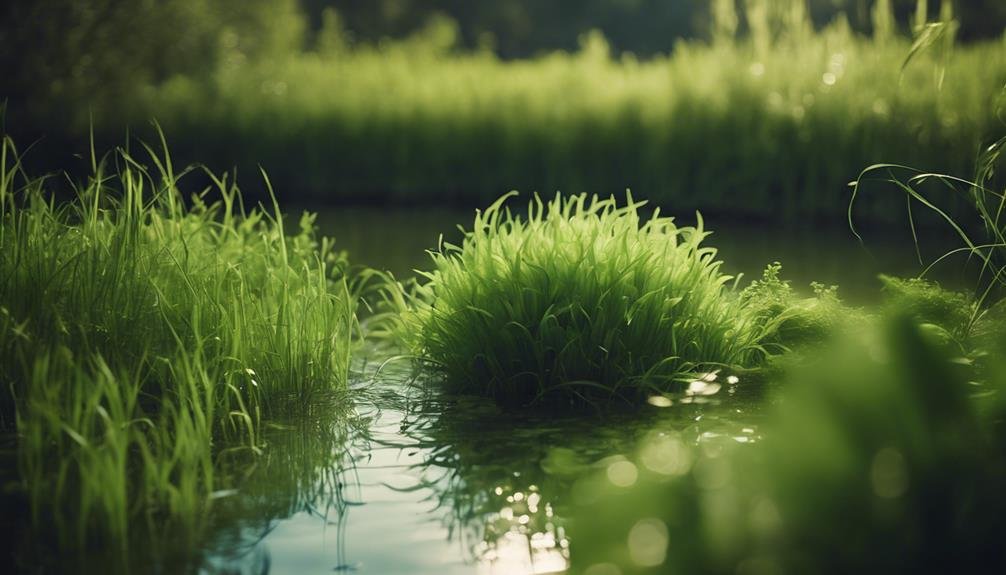
When it comes to addressing pond leaks in an environmentally friendly manner, aquatic plant barriers stand out as a practical solution. These barriers not only help in preventing water loss but also contribute to the overall health of the pond’s ecosystem. By creating a natural boundary, aquatic plant barriers play a vital role in maintaining water levels and supporting diverse aquatic life forms.
One of the key benefits of using aquatic plant barriers is their ability to reduce water evaporation, which is crucial for conserving water in ponds. Additionally, these barriers serve as a natural habitat for fish and other aquatic organisms, promoting biodiversity within the pond. Moreover, the roots of aquatic plants help in stabilizing the soil around the pond edges, preventing erosion and maintaining the structural integrity of the pond.
Installing aquatic plant barriers involves strategically placing a variety of water plants along the pond perimeter. Popular plant species used for barriers include water lilies, cattails, and water hyacinths, known for their ability to thrive in aquatic environments and create a natural barrier against water loss. Proper maintenance, such as regular trimming and monitoring of plant growth, is essential to ensure the effectiveness of these barriers in the long run.
Benefits of Barriers
Installing aquatic plant barriers in ponds effectively prevents the spread of invasive plants, promoting a healthier ecosystem. These barriers offer several key benefits. Firstly, they protect biodiversity by allowing native species to flourish, creating a balanced and diverse aquatic environment.
Secondly, barriers enhance water quality by preventing the growth of nuisance plants that can deplete oxygen levels and release toxins into the water.
Moreover, using barriers is a cost-effective long-term solution that eliminates the need for frequent chemical treatments or manual removal.
Additionally, the aesthetic appeal of clear waters and controlled vegetation enhances the overall beauty of the pond and its surrounding landscape.
These benefits highlight the importance of incorporating aquatic plant barriers into pond management strategies to protect delicate ecosystems and promote a harmonious balance between native flora and fauna.
Installation Techniques
To ensure the aquatic plant barriers work effectively, we need to follow proper installation techniques. Start by clearing the pond area of any debris or vegetation where the barrier will be placed.
Then, lay out the barrier material along the pond’s edge, ensuring it extends a few feet into the water and up the bank. Secure the barrier in place using eco-friendly landscape stakes or rocks, making sure to overlap the seams by at least six inches to create a tight seal and prevent gaps.
In areas with steep slopes or high water flow, consider trenching the barrier into the ground for added stability. If there are existing plants in the pond, carefully transplant them to a different area during installation and reintroduce them once the barrier is secure.
Proper installation is crucial for maximizing the barrier’s effectiveness and durability, safeguarding our aquatic environments from invasive species while promoting the growth of native plants.
Biological Pond Treatments
Biological pond treatments utilize the power of microorganisms to seal cracks and fissures, offering a sustainable and eco-friendly solution for leaks. These treatments work by introducing beneficial bacteria that create a bio-film to seal the pond’s structure.
Enzymes are also used to break down organic matter, forming a cementing sludge that fills gaps and holes. Compressed peat, which expands in water, can serve as a natural plug for small leaks.
Additionally, plant-based polymers derived from renewable sources are used to create a durable and flexible seal. These methods provide a natural and effective way to maintain the integrity of ponds without relying on traditional liners or chemical sealants.
Rainwater Harvesting Solutions
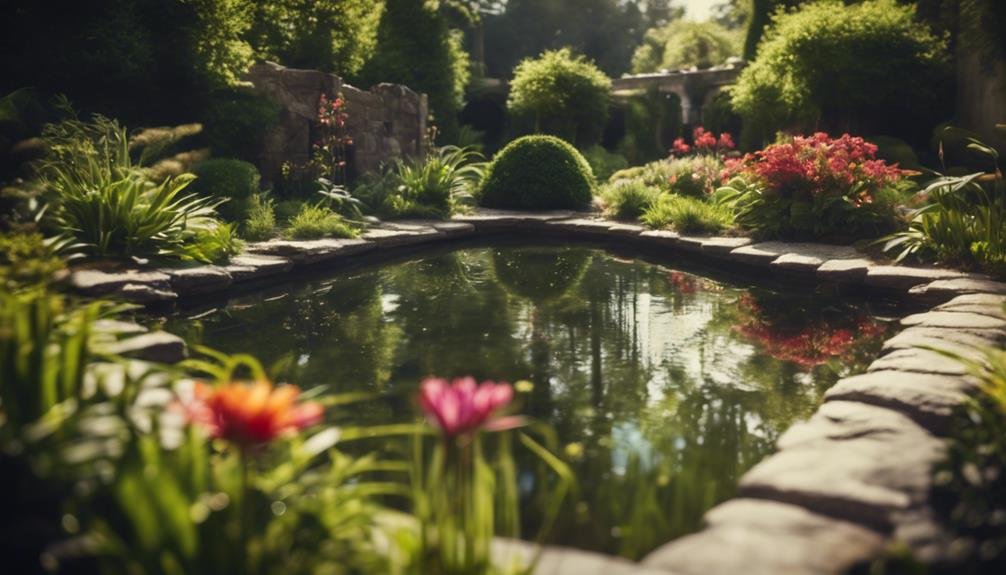
Rainwater harvesting is a smart eco-friendly solution for replenishing leaking ponds. By collecting rainwater from rooftops or other surfaces using gutters, pipes, and storage tanks, we can refill the pond and reduce the strain on essential water sources.
The beauty of rainwater harvesting lies in its sustainability. It allows us to make use of a natural resource that would otherwise be wasted, lessening our dependence on groundwater or treated water supplies. Rainwater is also free from chlorine, minerals, and other contaminants often found in tap water, making it perfect for maintaining a healthy pond ecosystem.
To set up a rainwater harvesting system, we’ll need a catchment area such as a roof, gutters for water flow, a storage tank, and possibly filters or a sediment trap. The system’s size will depend on the desired water volume and local rainfall patterns.
With proper installation and upkeep, rainwater harvesting can offer a reliable, environmentally friendly water source for our leaking pond.
Eco-Friendly Pond Accessories
To boost our pond’s eco-friendliness, we can opt for accessories that have minimal impact on the environment. Solar pond aerators are a great choice as they run on batteries and oxygenate the water without using electricity from non-renewable sources.
Another eco-friendly option is natural filtration systems, which use biological filters made from materials like gravel, sand, and aquatic plants to keep the water clean without the need for energy-intensive mechanical filters.
Choosing recycled pond liners made from materials like rubber or eco-friendly plastics can also help reduce our environmental footprint. Additionally, incorporating native aquatic plants into the pond not only enhances its beauty but also helps maintain water quality by absorbing excess nutrients and providing habitats for beneficial organisms.
It’s essential to prioritize durability, energy efficiency, and sustainability when selecting eco-friendly pond accessories. By making mindful choices, we can create a thriving aquatic ecosystem while minimizing our impact on the environment.
Conclusion
If other solutions don’t work, consider embracing the leak in your pond and turning it into a sustainable energy source by installing a small hydroelectric generator.
This way, you can power your home while appreciating nature’s unpredictable ways.
Just remember to have some orange safety cones on hand to prevent any slips on wet surfaces.

